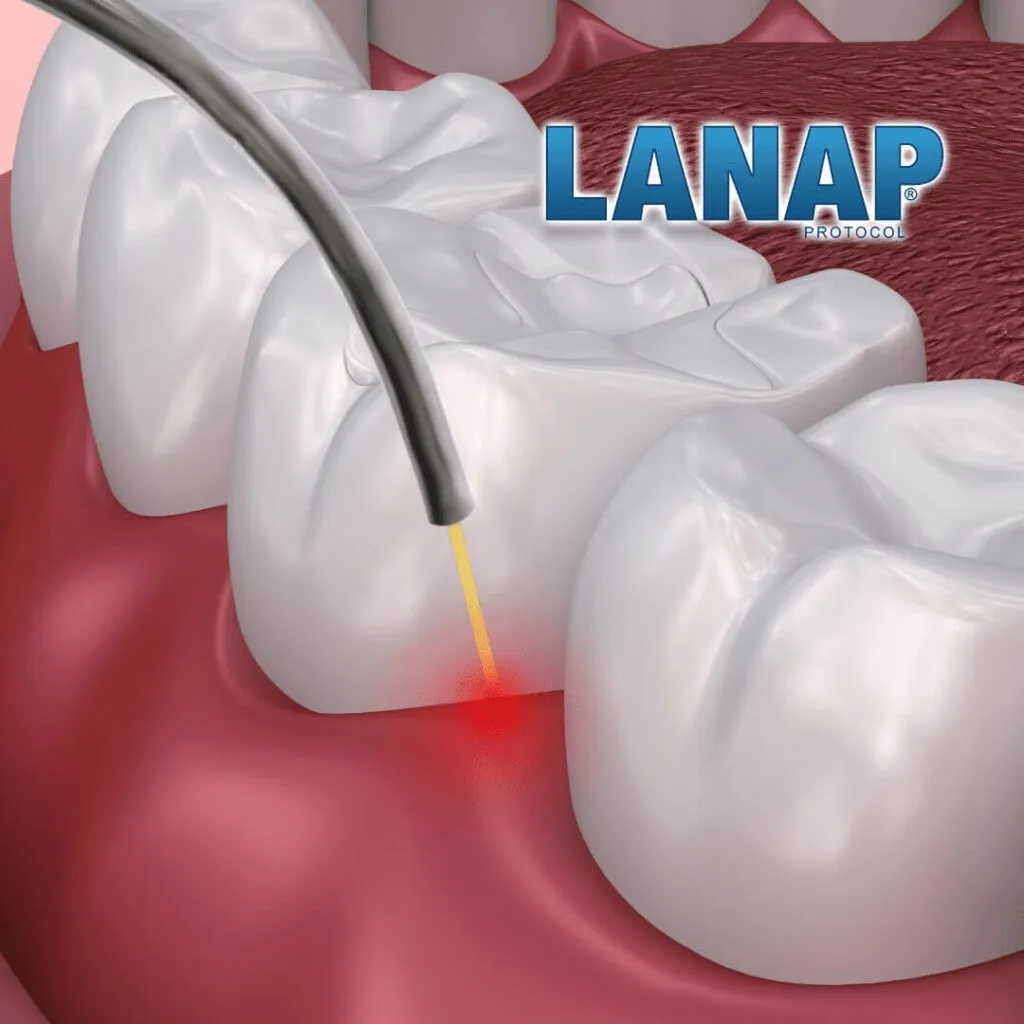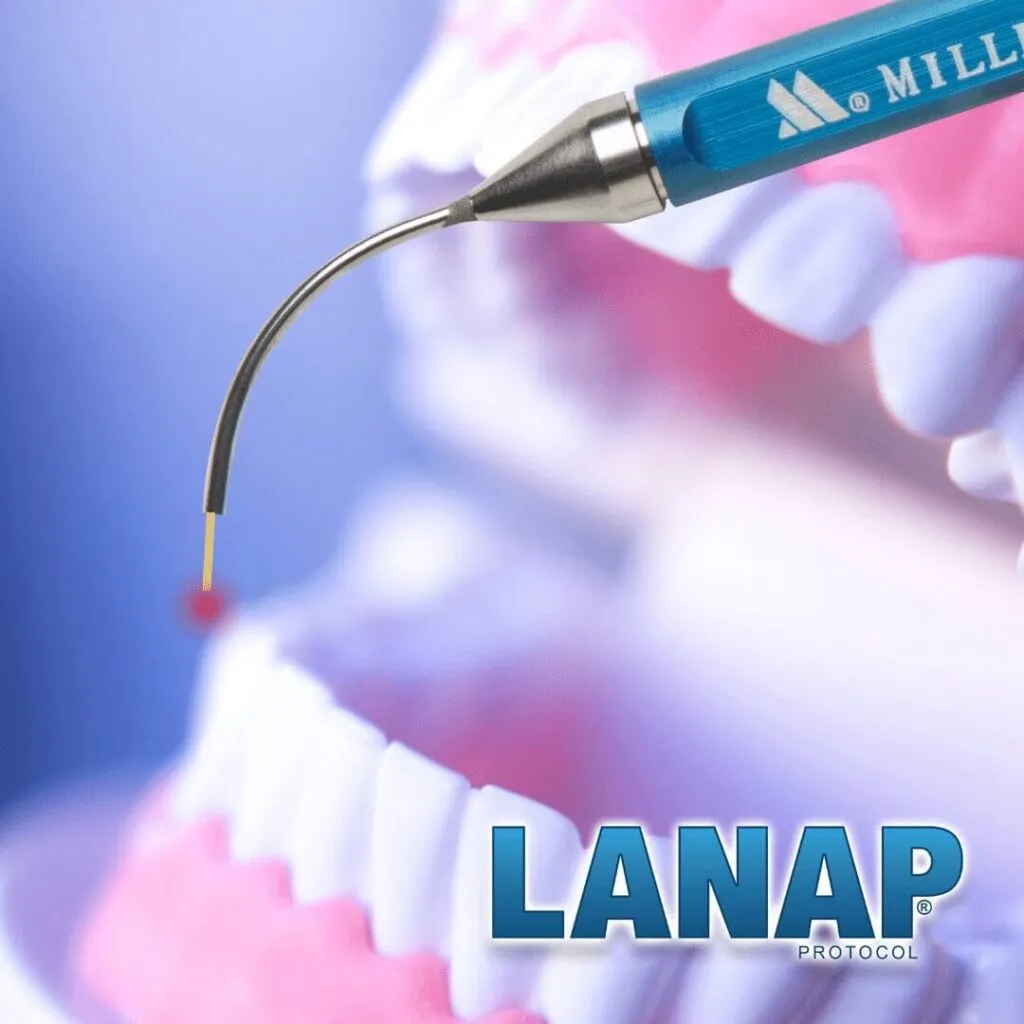The LANAP protocol is a laser-based treatment for gum disease. There is no cutting and suturing with the LANAP protocol. Patients typically report less pain and discomfort during and after the procedure, compared to traditional periodontal surgery.This patient riendly procedure helps you get healthy again comfortably, without fear.Generally, the LANAP protocol is less invasive than traditional surgery and helps maintain a beautiful smile line. The LANAP protocol is a patented periodontal treatment, cleared by the FDA in 2004. The procedure can only be done with the PerioLase® MVP-7; this laser operates at a specific wavelength that attacks the bacteria that contributes to gum disease while leaving healthy tissue intact. Post-surgical recession and toothsensitivity, which can besignificant following traditional gum surgery, are also greatly reduced
Patient Benefits:
- Faster Healing–LANAP® treatmentis minimally invasive and allows the body to recover and heal more quickly.
- Less Discomfort–Patients report less discomfort during and after surgery.
No Cut, No Sew, No Fear–the LANAP protocol uses laser light energy to eliminate the bacteria that cause gum disease, and help your mouth recover faster - Minimal Recovery Time–Most patients can immediately return to their daily routine.
Little to No Gum Recession–Because the procedure doesn’t require cutting the gums, there is less risk of recession and your beautiful smile is maintained. - Reduction in GumInflammation and Bleeding–The PerioLase® MVP-7™ targets inflammatory bacteria without injuring healthy tissue.
- Saves Teeth–Patients can keep their natural teeth sometimes even when the teeth have been deemed ‘hopeless’ with traditional treatments. Keeping your natural teeth has been linked to a longer lifespan!
- Safe for patients with Health Concerns–LANAP®protocolis safe for patients with health concerns such as diabetes, HIV, hemophilia, or those taking medications such as Plavix or aspirin.
Frequently Asked Questions
What to Expect: Your LANAP Surgery
LANAP periodontal surgery is a full-mouth procedure usually completed in two 2-hour visits. We complete one side of the mouth during the first visit, and complete the other side on the second visit. Surgeries are usually scheduled within one week of one another. It is common to quickly return to work or other activities.
What to Expect: The First Few Days
You may experience mild aching, throbbing, and soreness of the treated areas for the first couple days—this can be helped with mild pain medications. The tissue around the teeth may appear discolored. Your bite may feel slightly different, but the teeth will adapt. You cannot brush or floss for the first 7-10 days after treatment, and you will need to follow a liquid or mushy diet. Smoking decreases results for all gum treatments, including LANAP.
What to Expect: Follow-up Care
As the gums heal, the teeth will shift, and your bite will need to be adjusted several times over the coming months. Splints may be fabricated to stabilize and immobilize the teeth. It is important that you wear these splints as instructed to promote healing. Expect to have your teeth professionally cleaned every three months for at least the first year, and then as recommended by your dentist.
Who is a candidate for LANAP laser surgery?
Patients with moderate-to-severe gum disease can especially benefit from the LANAP protocol. The LANAP protocol is also an excellent treatment option for patients who are fearful of conventional scalpel surgery and patients taking certain medications, such as blood thinners. With the LANAP protocol, patients do not have to stop taking any medications.
Why is it important to get my gum disease treated?
The health risks of gum disease go far beyond the loss of teeth. There is a connection between gum disease and a number of serious medical conditions. People with periodontal disease are almost twice as likely to suffer from coronary artery disease, and have nearly twice the risk of having a fatal heart attack. Gum disease has also been linked to other health problems, including respiratory disease, diabetes, Alzheimer’s, certain cancers, heart disease, stroke, osteoporosis, erectile dysfunction, HPV, and pregnancy complications.
Can the LANAP protocol help my loose dental implants?
Yes! Using the PerioLase MVP-7, we can often save ailing or failing implants in a similar manner using the LAPIP™ protocol. We use the same laser, but different laser settings and light exposure that will help your implant stabilize while destroying periodontal pathogens and endotoxins.

About Gum Disease
What Is Gum Disease?
Gum disease begins when a film called plaque accumulates on the teeth and calcium from saliva hardens the plaque—this calcified plaque is called tartar or calculus. Certain types of germs that live in this plaque and calculus damage gum tissue. Your body tries to fight this infection with an inflammatory attack, sending white blood cells to the area to destroy the bacteria. This inflammation causes the tissue to bleed easily when you brush or floss. This stage of the condition is called gingivitis.
If the infection and inflammation persist the result is a chronic inflammatory condition where, in addition to the gums, ligament and bone around the teeth are destroyed—often with no symptoms. At this stage it is called periodontitis.
Signs/Symptoms of Moderate-Advanced Gum Disease Include:
- Gums that are red, swollen, and bleed easily
- Gums that seem to have pulled away from the teeth
- Bad breath or halitosis
- Pus between your teeth and gums
- Teeth that seem to be loose or moving away from one another
- Change in the way your teeth fit together when you bite
- Change in the way your partial denture or implant-supported restorations fit
- Or no symptoms at all!

What Are the Risk Factors for Gum Disease?
Well known risk factors for periodontitis include genetics, stress, avoiding the dentist, no brushing or flossing, and some medical conditions. Smokers are significantly more likely to develop gum disease than non-smokers.
It’s not just about your teeth anymore — gum disease has been linked to numerous health problems, with new studies emerging all the time linking oral and overall health.
- Alzheimer’s Disease
- Stroke
- Respiratory Disease
- Breast Cancer
- Heart Disease
- Pregnancy Complications
- Kidney Cancer
- Rheumatoid Arthritis
- Pancreatic Cancer
- Blood Cancer
- Diabetes
- Osteoporosis


